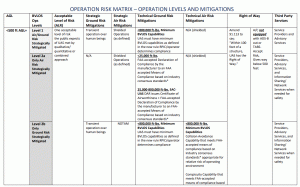The Federal Aviation Administration’s UAS Beyond Visual Line of Sight Aviation Rule Making committee (UAS-BVLOS ARC) has issued its final recommendations, including the need for the FAA to set acceptable level of risk targets for all types of drone operations.
In terms of key outputs, the ARC recommends that:
- First, the FAA set an acceptable level of risk (ALR) for UAS that is consistent across all types of operations being performed. The ARC envisions that this approach will allow the FAA to adopt a common and consistent set of regulations and guidance, giving operators the flexibility to meet the ALR through qualitative or quantitative methods, or a hybrid approach.
- Second, a series of modifications to the right of way rules in Low Altitude Shielded Areas (within 100’ of a structure or critical infrastructure as defined in 42 U.S.C. § 5195c) and in Low Altitude Non-Shielded Areas (below 400’) to accommodate UA operations. Specifically, the ARC recommends several amendments to 91.113 to: allow automatic means for see-and-avoid responsibility; give UA right of way over crewed aircraft that are not equipped with ADS-B or TABS in Non-Shielded Low Altitude Areas; and give crewed aircraft that are equipped with ADS-B or TABS (and broadcasting their position) right of way in Non-Shielded Low Altitude Areas.
- Third, the ARC recommends an approach to operator qualification that would extend Part 107, Remote Pilot Certificate with Small UAS Rating, to cover topics associated with Extended Visual Line of Sight (EVLOS) and shielded UAS operations. The recommendation creates a new Remote Pilot certificate rating to cover BVLOS operations beyond the scope of the extended Part 107 rating. The examination for both ratings would consist of a knowledge test on relevant areas, while practical training and qualifications would be tied to new Remote Air Carrier and Remote Operating certificates, which would be required for most commercial 1-to-many operations. The qualifications would be based on specific UA systems, Use Cases, and operational restrictions.
- Fourth, the ARC recommends that the FAA establish a new BVLOS Rule which includes a process for qualification of UA and UAS, applicable to aircraft up to 800,000 ft-lb of kinetic energy (in accordance with the Operation Risk Matrix).
- Finally, the ARC recommends that the FAA adopt a non-mandatory regulatory scheme for third party services to be used in support of UAS BVLOS operations.
Other key recommendations and considerations include:
“The ARC is recommending conspicuity requirements for UAS to mitigate visibility risks. The requirements could include strobe or other lighting features, or a paint scheme that increases visibility. The FAA should consider establishing a Means of Compliance through a standards development organization (SDO) for conspicuity requirements.
“In consideration of flight over people, the ARC considered a variety of approaches and factors in order to enable flight over people. Discussions were held regarding the number of people exposed to a UAS operation, relative-time exposure, and methodologies to determine exposure in BVLOS operations, etc. One method to determine number of people exposed to a UAS operation may be population densities. The ARC noted that population density values may not correlate to an accurately assessed risk level. A static population density may not account for dynamic circumstances in which the exposed number of people varies from a documented or published population density.
On the critical area of risk assessment, the ARC committee outlined a risk matrix (see below) and reported:


“While there was agreement in the ARC that determining an acceptable level of risk (ALR) was the best approach, there was some disagreement about how an ALR should be implemented. While the majority of the ARC desired a single value for all operations, some members suggested that the level should vary based on the type of operation. After substantial discussion, the consensus of the ARC is that a single set of ALR is appropriate to support all types of BVLOS operations. The set of ALR values should be consistent across all BVLOS operation levels. This approach is expected to ease implementation, increase understanding, and streamline compliance methods while promoting interoperability between differing UAS use cases.
“The expectation is that operators will be able to demonstrate they meet the ALR using qualitative methods, quantitative methods, or a combination of both. This is similar to existing Safety Management System constructs where a value is assigned and both qualitative and quantitative approaches are accepted to show compliance. When selecting ALR values, the ARC proposes that the FAA base the quantified UA ALR values upon historical publicly accepted values for the risk associated with performing similar tasks using more traditional means. This is sometimes referred to as risk transference. The basis for risk transference is that the public understands that the tasks being performed incur a certain amount of risk, which they accept in return for the value of that task.
“It is thus reasonable to infer that if the method of performing that task changes, the risks associated with that method should be as low or lower than what the public currently accepts. In the case of UAS, this assumption is expected to be conservative, as the UAS operation is expected to bring additional societal and economic benefits that would increase the public’s acceptance of UAS performing those operations. Over time, as UAS operations become more common and more data is collected, the acceptable levels of risk can be adjusted, as is done in traditional aviation. Risk Assessment Methodology When considering risk in aviation, there are three types of parties that may be involved:
- People on-board the aircraft (1st party risk);
- People on-board another aircraft (2nd party risk);
- People on the ground who are not participating in aviation (3rd party risk)”
For more information
https://www.faa.gov/regulations_policies/rulemaking/committees/documents/media/UAS_BVLOS_ARC_FINAL_REPORT_03102022.pdf
(Image: Shutterstock)




